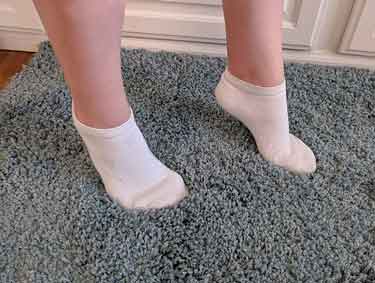Toe-Walking
Children with toe-walking are often referred to Pediatric Orthopedics, Physical Medicine and Rehabilitation, and/or Pediatric Neurology for evaluation and treatment. While most toe-walking is benign and idiopathic, in some children, it may be caused by a condition such as cerebral palsy, hereditary motor-sensory neuropathies, spinal cord tumors, muscular dystrophy, autism spectrum disorder, hereditary spastic paraparesis, hip dysplasia, or other orthopedic conditions. [Ustaris: 2018] According to one study, an underlying diagnosis was found for 62% of all children presenting with toe-walking. [Ustaris: 2018]
Signs & Symptoms
Toe-walking occurs when there is no heel strike during the stance phase of the gait cycle. Children walk on their tip-toes, and they may not be able to stand with their feet flat on the ground. The gastrocnemius and soleus muscles (which, together, form the Achilles tendon) can be tight, but feet should otherwise be normal in appearance. Children may complain of pain in their calves. Parents sometimes complain that the child with toe-walking wears their shoes out in an unusual manner.
Evaluation
Although most children who toe-walk do not have an underlying condition, disorders of the brain, spinal cord, or nerves/muscles can result in toe-walking. Certain historical clues, such as prematurity, delayed age of initial walking, and/or other developmental milestones, may be noted. A family history of a neuropathy or muscular dystrophy can be associated with the onset of toe-walking. Additionally, unilateral toe-walking, or recurrent toe-walking after treatment, may be associated with other orthopedic abnormalities (e.g., hip dysplasia).
Any child who is toe-walking after walking is well established, around age 2 or 3, needs a complete medical history and neurologic exam, as well as an orthopedic evaluation. If no other problem is identified, specific tests, such as X-rays, CT/MRI scans, and NCV/EMG are not usually needed.
During the exam, attention should be paid to distinctive features suggesting a syndrome. A full neurologic exam should be performed as possible for age, including strength testing, reflexes, tone, sensation, examination of the spine, and lower limb examination for large calves, leg length discrepancy, and range of motion.
Disorders of the Brain
Disorders of the Spinal Cord
Disorders of Nerves/Muscles
Treatment
Some children may only need reminders from family to walk flat on their feet. Children with sensory integration disorders may benefit from occupational therapy. Treatment of persistent toe walking often involves a period of casting or bracing accompanied by physical therapy to help stretch the muscles and tendons in the calves and encourage a normal gait. Botulinum toxin injections for tight heel cords have been beneficial in some children. In more severe cases, surgery can be necessary to lengthen the Achilles tendon. With treatment as needed, most children (up to 79% in 1 Swedish study) can walk flat on their feet over time. [Engström: 2018]
Resources
Information & Support
The following provides further information about related conditions:
For Professionals
Toe Walking (OrthoInfo)
Information about toe walking, including anatomy, causes, symptoms, examination, and treatment; from the American Academy
of Orthopaedic Surgeons.
Pediatric Gait Analysis
Project ECHO video recording from the Salt Lake City, UT Shriners Gait Lab regarding idiopathic toe-walking.
Services for Patients & Families in Rhode Island (RI)
| Service Categories | # of providers* in: | RI | NW | Other states (3) (show) | | NM | NV | UT |
|---|---|---|---|---|---|---|---|---|
| Pediatric Neurology | 18 | 5 | 5 | 8 | ||||
| Pediatric Orthopedics | 16 | 4 | 7 | 8 | 10 | |||
| Pediatric Physical Medicine & Rehabilitation | 6 | 3 | 3 | 3 | 11 | |||
For services not listed above, browse our Services categories or search our database.
* number of provider listings may vary by how states categorize services, whether providers are listed by organization or individual, how services are organized in the state, and other factors; Nationwide (NW) providers are generally limited to web-based services, provider locator services, and organizations that serve children from across the nation.
Helpful Articles
Sivaramakrishnan S, Seal A.
Fifteen-minute consultation: A child with toe walking.
Arch Dis Child Educ Pract Ed.
2015;100(5):238-41.
PubMed abstract
Authors & Reviewers
| Authors: | Lynne M. Kerr, MD, PhD |
| Marcella Woiczik, MD |
Page Bibliography
Engström P, Tedroff K.
Idiopathic Toe-Walking: Prevalence and Natural History from Birth to Ten Years of Age.
J Bone Joint Surg Am.
2018;100(8):640-647.
PubMed abstract
Ruzbarsky JJ, Scher D, Dodwell E.
Toe walking: causes, epidemiology, assessment, and treatment.
Curr Opin Pediatr.
2016;28(1):40-6.
PubMed abstract
Sivaramakrishnan S, Seal A.
Fifteen-minute consultation: A child with toe walking.
Arch Dis Child Educ Pract Ed.
2015;100(5):238-41.
PubMed abstract
Ustaris LM, Seidman R, Bindra T, Basak R.
Toe walking after three: how serious could it be?.
BMJ Case Rep.
2018;2018.
PubMed abstract / Full Text


 Get Help in Rhode Island
Get Help in Rhode Island